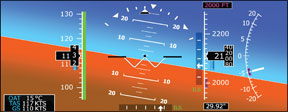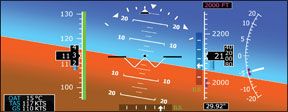Its nearing dusk as two Piper Senecas descend toward Highfuelprices Regional Airport on vectors for the VOR approach. Published minimums are 500 and 1. The airport has weather reporting and forecasting, the airplanes have the same avionics. Seneca A is being flown by a pilot with commercial, instrument and multi-engine ratings and a current Part 135 approval; the flight is being operated under Part 135 as there is a five-pound box of urgent documents under the cargo net 288 behind the rear seats. Meanwhile, Seneca B is being flown by a pilot with commercial, instrument and multi-engine ratings, a 23-month-old flight review and some question as to whether he is instrument-current. It is a Part 91 flight. There are four passengers on board who are splitting the cost of the flight with the pilot. Before they reach the final approach fix, the controller advises both aircraft that the airport weather is now 400 overcast and mile visibility in rain and mist. Seneca A pilot advises the controller she cannot continue the approach and that shed like to climb 1000 feet or so and hold at the FAF while she decides whether to go to her alternate or wait for the weather to improve. The pilot of Seneca B hears the weather report and continues with the approach because he wants to take a look. Both pilots are making decisions in compliance with the regulations: The Part 135 (or Part 121) pilot may not begin an instrument approach procedure if the current weather report available to the pilot says the airport is below IFR landing minimums for the approach (FAR 135.225). Under Part 91, there is no such restriction. The FAA has long provided a “higher level of safety” for paying passengers (which coincidentally includes freight). A Part 91 pilot is given more latitude to kill himself (and take his friends and family with him). Taking A Look Before anyone gets excited about us missing something, yes, Part 121 and 135 pilots do get a little of Part 91s “Hey, yall, lets just go take a look” authority to descend to the MDA or DA/DH in the circumstance where the weather was above approach minimums, and only after passing the FAF did the pilot get the report of weather below minimums. For those pilots authorized to take a look, that is, to descend to the MDA or DH/DA when the weather is below published minimums, the regulations for all operators become identical at the MDA or DH/DA: the approach may not be continued for a landing unless both the minimum flight visibility prescribed for the approach exists and the pilot can clearly see one or more of the items delineated in 91.175(3). The result? Its no surprise that Part 91 pilots take advantage of their right to “take a look” and a depressingly significant number keep trying to see something as they descend through the prescribed minimums and shortly thereafter smack into the ground, trees, power lines or antennas rather than land on the desired runway. Its also no surprise that only a few 121/135 operators find themselves even able to “take a look” each year, as there just arent that many times that the weather tanks in the two or three minutes that the airplane is on the approach past the FAF and, of those, very few press on determined to find the runway and bust minimums some short time before busting themselves. A Different Approach? We can rail all we want about the stupidity of descending below minimums; and folks have been waving their arms about how terribly unsafe it is (theyre right) for decades, yet the accident rate for descent below minimums stays pretty constant year after year. Maybe, just maybe, there needs to be a different approach to the situation. Maybe the answer is for pilots to refuse to begin the approach at all, despite “taking a look” being legal because of the way humans behave when near airports. Maybe we accept that pilots really arent stupid but, as humans, are subject to intensely powerful psychological forces that cause very smart pilots to bust minimums and die. There is an excellent book on one of these forces, called “plan continuation bias,” by some seriously competent NASA scientists (its available from Amazon.com and is thoroughly discussed on NASAs Web site; the title is, 
Tied to plan continuation bias is the old psychological principle of partial reinforcement. Simply put, its why casinos win staggering sums of money from people who gamble. If you put a pilot in front of a one-armed bandit and he gets his money back every time he pulls the lever, hell quickly get bored and go away. However, if you randomly allow him to get back some of the money hes spent, hell yank the lever far longer than he intended, often until he runs out of money.
The same principle applies to the occasional times a pilot busts minimums by a little and is able to land. He does it very cautiously at first, and still misses some approaches, but the hook is set. He is successful every once in a while on a low approach by going 50 or 100 feet below minimums. His behavior pattern is established. He busts minimums regularly; and he gets in every once in a while, even though he knows in his heart of hearts that it is a dangerous, bad idea.
Soon hes willing to go down another 100 feet, and then another. You know the rest. Those who become compulsive gamblers at casinos wipe out the family fortune; those who become compulsive gamblers with minimums just wipe out.
Shades of Gray
Complicating the issue is that deciding to shoot an approach when weather is below minimums is simply not a black and white issue. True, the vast majority of the time its foolish, and a pilot who is honest with himself will either hold or divert before wasting time taking a look.
Most of the time the weather is not going to change fast enough that it pops above minimums magically while the pilot is getting close to the airport; the pilot is simply saying to the world that hes going to bust minimums by some amount, try to get in, and hope that someone who doesnt like him wont find out about it and turn him in.
However, there are localized weather conditions in parts of the U.S. where pilots know that the weather can be changing so fast that odds of getting in without busting minimums are high enough that its worth a try. Three that come to mind are coastal fogs in California that cover and uncover runways like a matador with a cape, lake-effect snow near the Great Lakes where visibility can go from /
16 to five miles (or the other way) in less than a minute, and fast-moving tropical rain squalls in the southern states. Those same pilots know the opposite can happen; they can be on the approach into a report of well-above-minimums weather, see the runway from a mile or two away, and then suddenly lose sight of it even as they get to flare height. They are always prepared for a go-around at the last minute.Whats a Part 91 pilot to do? Heres a suggestion: if pilots who are required to take recurrent training biannually as opposed to biennially are prohibited from continuing an approach when the airport is below minimums, there is something wrong with the picture of the biennially recurrent pilot being willing to press on, even if it is legal until the pilot gets to the MDA or DA/DH. We think a Part 91 pilot needs to recognize there are powerful psychological forces pushing him to do something that is legal but not wise (shooting the approach in the first place), and it can lead to doing something illegal and extremely unwise: busting minimums and crashing. And maybe, just maybe, he should decline the approach in the first place rather than do something where he is setting himself up to bust minimums.
In our opinion, the psychological principles of plan continuation bias and partial reinforcement, when combined with ability to shoot the approach when weather is reported below minimums and only requires the pilot to make the decision to abandon the approach near the very end, at the MDA or DA/DH, is a recipe for getting dead. Sadly, its one that is cooked up several times every year.
Rick Durden is a practicing avia-tion attorney and type-rated ATP/CFI with more than 6500 hours.




